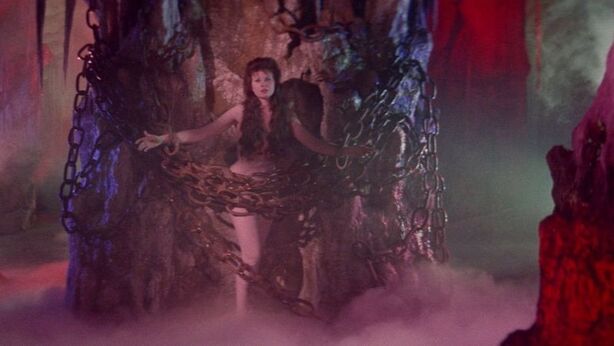 Welcome to a weekly series in which Doris V. Sutherland takes readers on a trip through the history of werewolf cinema... ...Hercules, Prisoner of Evil (1964) stars Reg Park as a muscle-bound hero of the ancient world (Ursus in the original Italian version, Hercules in the American dub). As he helps out a rural community in Central Asia, he runs into a problem that taxes even his mighty biceps: a hairy monster is loose in the forest and picking people off. While Hercules tries to sort things out, an evil Prince Regent (Furio Meniconi) takes a dislike to the hero and begins scheming to do away with him. Meanwhile, two rival princesses (Mireille Granelli and Maria Teresa Orsini) are competing for the throne, and one of them may well have something to do with the ravenous monster. What seems like a simple task for Hercules turns out to be rather more complex. Hercules, Prisoner of Evil, created by directors Antonio Margheriti and Ruggero Deodato and screenwriter Marcello Sartarelli and originally released in Italy as Ursus il dtei Kirghisi (literally “Ursus, Terror of the Kyrgyz”), is what you get when lycanthropic horror films collide headlong with the genre of Italian peplum. It belongs to a cycle of films about Ursus, a character originating in Henryk Sienkiewicz’s novel Quo Vadis; the American translators appear not to have been interested in nineteenth-century Polish literature, and so renamed him Hercules after a rather more famous muscleman. The fact that Reg Park had played Hercules in a pair of 1961 films (including the similarly horror-influenced Hercules in the Haunted World, co-starring Christopher Lee) doubtless added further impetus to the change. No heroic fantasy is complete without a monster of some sort, so it shouldn’t be a surprise to see monster movies bleeding into the peplum genre—although it’s not entirely clear what the monster is in this case. Hercules, Prisoner of Evil sometimes turns up in werewolf filmographies, but there’s room to debate how well the label fits. It involves a man shapeshifting into a hirsute killer, but the creature is in most scenes referred to simply as a “monster” (or, in one case, a “zombie”) and never as a werewolf. Meanwhile, the Universal-mandated paraphernalia of silver bullets, full moons and the like are absent. If we call Hercules, Prisoner of Evil a werewolf film, then we might as well do the same for just about any adaptation of Dr. Jekyll and Mr. Hyde. But hey, in fairness, the werewolf film canon is a little more interesting with Hercules, Prisoner of Evil than without it. Leaving lycanthropy aside and judging the film on its own merits, Hercules, Prisoner of Evil is an entertaining bit of cheap-and-cheerful peplum. One you get past the initially overpowering whiff of low-budget cheese, it becomes clear that the film knows exactly what it can achieve within its modest means. The monster make-up consists mainly of some additional body hair, but the film does something to obscure these limitations through fast-paced editing. Similarly, while It would be easy to scoff at scenes like the curious ballet dance performed in front of the Prince Regent when he first appears or the carnival sequence where the main characters are tailed by an acrobat and fire-juggler, these are simply the film trying its best to create spectacle on a budget that probably wouldn’t have covered catering for a Game of Thrones episode. Meanwhile, the plot—which initially seems to have been sketched on a napkin—turns out to be reasonably intricate, with a tidy little whodunit taking place behind the dashing heroics and supernatural horror. As for characterisation, well, what’s not to love about a film where the villains exchange lines like this: “You stay here and pretend you’re wounded, and when Hercules and his men get here tell them this was the work of the monster!” “And what if they see I’m not wounded? Aaggh!” “Now no-one can say you’re not wounded.” Nobody watches a film like Hercules, Prisoner of Evil expecting anything other than a large chunk of cheese. The nice surprise is that it turns out to be a higher grade of cheese than might have been expected. By Doris V. Sutherland Enjoy Doris' writing? Leave her a tip here through Ko-fi!
0 Comments
Leave a Reply. |
Archives
March 2023
|


 RSS Feed
RSS Feed